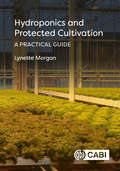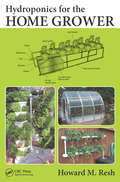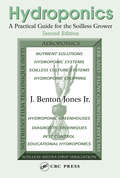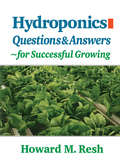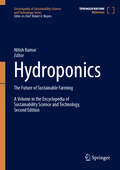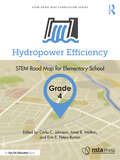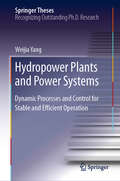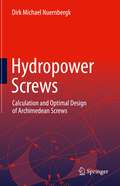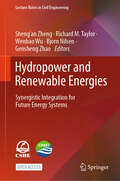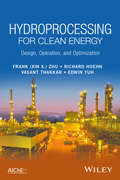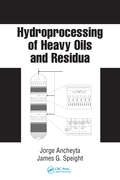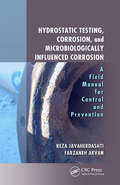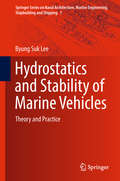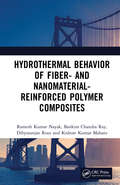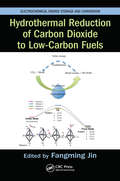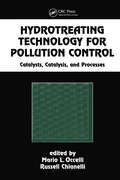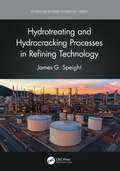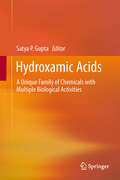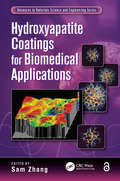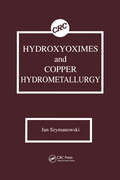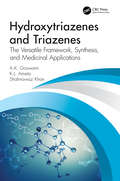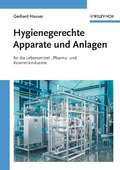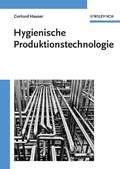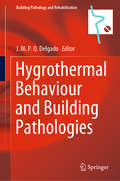- Table View
- List View
Hydroponics and Protected Cultivation: A Practical Guide
by Dr Lynette MorganA comprehensive, practical text which covers a diverse range of hydroponic and protected cropping techniques, systems, greenhouse types and environments. It also details the use of indoor plant factories, vertical systems, organic hydroponics and aquaponics. Worldwide hydroponic cropping operations can vary from large, corporate producers running many hectares of greenhouse systems particularly for crops such as tomato, cucumber, capsicum and lettuce, to smaller-scale growers growing fresh produce for local markets. Included in this book: Detailed technical information to help growers and students to design and run their own hydroponic operations. In-depth research to explain the factors that influence plant growth, produce quality, post-harvest life and hydroponic plant nutrition. New advances such as the use of organic nutrients and substrates, completely enclosed indoor plant factories and the growing number of small-scale, non-commercial applications. Hydroponics and Protected Cultivation is fully illustrated with colour images and photographs to illustrate key topics and help identify problem areas. It is suitable for growers, researchers and students in horticulture.
Hydroponics for the Home Grower
by Howard M. ReshHydroponics offers many advantages to traditional soil-based horticulture. These include greater control over many of the limiting factors, such as light, temperature, and pests, as well as the ability to grow plants in all seasons. With instruction from one of the top recognized authorities worldwide, Hydroponics for the Home Grower gives you step
Hydroponics: A Practical Guide for the Soilless Grower
by J. Benton Jones Jr.Revolutionary hydroponic/soilless advances are being achieved by efficiently improving results with the application of new concepts, methods, and equipment. The new edition of a bestseller, Hydroponics: A Practical Guide for the Soilless Grower has been revised to reflect these advances with new chapters that provide essential information on greenh
Hydroponics: Questions & Answers for Successful Growing
by HowardM. ReshFirst published in 2002. CRC Press is an imprint of Taylor & Francis.
Hydroponics: The Future of Sustainable Farming (Encyclopedia of Sustainability Science and Technology Series)
by Nitish KumarThis handbook covers both principal and applications aspects of hydroponics. This reference book shows the state-of-the-art in this area, while offering a clear view of supplying plants with nutrients other than soil. Chapters about hydroponics provides the reader with an understanding of the properties of the various soilless media and how these properties affect plant performance in relation to basic agricultural operations, such as fertilization and irrigation. Chapters explore the drawbacks and advantages of using hydroponics as a soilless crop production system and provide a wider view of science, technology, and economic impact of hydroponics. This book is a valuable resource to agriculturists, horticulturalists, greenhouse and nursery managers, and professionals involved with the production of plants. The handbook provides chapters about technology and applications of hydroponics. It contains an overview of the relevance of aquaponics in the fulfillment of the SDGs.
Hydropower Efficiency, Grade 4: STEM Road Map for Elementary School (STEM Road Map Curriculum Series)
by Carla C. Johnson Janet B. Walton Peters-Burton, Erin E.What if you could challenge your fourth graders to create a minimally invasive, highly efficient dam? With this volume in the STEM Road Map Curriculum Series, you can! Hydropower Efficiency outlines a journey that will steer your students toward authentic problem solving while grounding them in integrated STEM disciplines. Like the other volumes in the series, this book is designed to meet the growing need to infuse real-world learning into K–12 classrooms.This interdisciplinary, four-lesson module uses project- and problem-based learning to help students create a highly efficient dam that has a minimal impact on the environment. Students will explore the use of natural resources to provide energy needs, specifically hydropower, while exploring the workings of watermills, wind turbines, and generators to help build an understanding of the effects of dams. In creating their dam, they will learn about the various types of alternative hydropower sources, including wave and tidal power, and track the progress of electrification in the U.S. on a timeline; alongside researching the positive and negative consequences of hydropower.To support this goal, students will do the following: Use the engineering design process (EDP) to create a design for a dam, wind turbine, and water wheel Compare and contrast renewable power sources Evaluate power sources for efficiency Identify positive and negative consequences of human modifications of the environment Identify and describe how several sources of renewable energy are used across the U.S. Use mapping skills to determine where natural resources are being accessed for energy usage Effectively utilize shapes, materials, and measurements to create a model of a hydropower system The STEM Road Map Curriculum Series is anchored in the Next Generation Science Standards, the Common Core State Standards, and the Framework for 21st Century Learning. In-depth and flexible, Hydropower Efficiency can be used as a whole unit or in part to meet the needs of districts, schools, and teachers who are charting a course toward an integrated STEM approach.
Hydropower Plants and Power Systems: Dynamic Processes and Control for Stable and Efficient Operation (Springer Theses)
by Weijia YangThis book reports on a comprehensive study addressing the dynamic responses of hydropower plants under diverse conditions and disturbances, and analyzes their stability and oscillations. Multiple models based on eight existing hydropower plants in Sweden and China were developed and used for simulations and theoretical analysis with various degrees of complexity and for different purposes, and compared with on-site measurements for validations. The book offers important insights into the understanding of the hydraulic, mechanical and electrical coupling mechanisms, up to market conditions and incentives. It recommends control strategies for a more stable and efficient operation of hydropower plants.
Hydropower Screws: Calculation and Optimal Design of Archimedean Screws
by Dirk Michael NuernbergkWater screw conveyors have been in use for centuries. Their invention is attributed to Archimedes. However, the idea of using this Archimedean screw also as a hydropower screw to convert hydraulic energy into electrical energy did not emerge until the 1990s. More recently, hydropower screws have been used very frequently at hydropower sites and have now also attracted increasing interest from scientists and users worldwide. This is due to the machine's very good efficiency, it's simple and inexpensive design, and its fish compatibility. This book provides calculation fundamentals for hydropower screws. The author focuses on the description of the hydraulic processes and gives a design flow that can be used to design hydropower screws. The hydraulic behavior, dimensions, speed, efficiency, forces acting on the screw such as sag or lift, as well as the arrangement of the gearbox and the choice of generator are discussed. The theoretical equations, some of which are newly derived, are applied using examples. Finally, a design flow is given that can be used to easily adapt an optimally designed hydropower screw to a location. New findings presented in various scientific publications have been incorporated into the translation of the second German edition. In addition, experiments were carried out at different locations, which led to a better understanding of the available data basis. This has allowed the theoretical predictions of this book to be confirmed experimentally. In addition, the author has investigated a number of faulty installations and has been involved in the design of successful working waterpower plants equipped with hydropower screws.
Hydropower and Renewable Energies: Synergistic Integration for Future Energy Systems (Lecture Notes in Civil Engineering #487)
by Gensheng Zhao Sheng’an Zheng Richard M. Taylor Wenhao Wu Bjorn NilsenThis open access book explores the complementarity of hydropower with new energy sources such as solar and wind in the global energy transition. It analyzes the technological advantages, environmental impacts, and economic potential of combining hydropower and new energy sources, while examining the related policies and market mechanisms. Through a multidimensional approach, the book demonstrates the importance of this energy integration in improving energy system efficiency, reducing carbon emissions, and promoting sustainable development. Starting with the challenges and strategies of technology integration, the book will explore the role of smart grid management and energy storage technologies in this context, providing quantitative and qualitative assessments of the ecosystem and socio-economic impacts of such energy synergies. Valuable knowledge and practical guidance for energy researchers, policy makers and professionals in the field of sustainable development.
Hydroprocessing for Clean Energy: Design, Operation, and Optimization
by Edwin Yuh Frank Xin Zhu Richard Hoehn Vasant ThakkarProvides a holistic approach that looks at changing process conditions, possible process design changes, and process technology upgrades Includes process integration techniques for improving process designs and for applying optimization techniques for improving operations focusing on hydroprocessing units. Discusses in details all important aspects of hydroprocessing - including catalytic materials, reaction mechanism, as well as process design, operation and control, troubleshooting and optimization Methods and tools are introduced that have a successful application track record at UOP and many industrial plants in recent years Includes relevant calculations/software/technologies hosted online for purchasers of the book
Hydroprocessing of Heavy Oils and Residua (Chemical Industries)
by James G. Speight Heinz HeinemannMany oil refineries employ hydroprocessing for removing sulfur and other impurities from petroleum feedstocks. Capable of handling heavier feedstocks than other refining techniques, hydroprocessing enables refineries to produce higher quality products from unconventional- and formerly wasted- sources. Hydroprocessing of Heavy Oils and Residua
Hydrostatic Testing, Corrosion, and Microbiologically Influenced Corrosion: A Field Manual for Control and Prevention
by Reza Javaherdashti Farzaneh AkvanHydrostatic Testing, Corrosion, and Microbiologically Influenced Corrosion: A Field Manual for Control and Prevention teaches industry professionals, managers, and researchers how to combat corrosion failure associated with hydrotesting. It discusses how a test liquid must be selected, how corrosion by bacteria should be controlled, and how to eliminate the risk of leakage. Rather than teaching how hydrotests should be conducted, it helps the reader evaluate the quality of a hydrotest that’s already been conducted in terms of oxygen scavenger use, biocide testing, inhibitor addition, and water quality and explains the tasks that top and middle management must ensure are taken with respect to corrosion assessment of hydrotesting. The manual also discusses microbiologically influenced corrosion (MIC) as the main corrosion mechanism related to post-hydrotesting and offers essential knowledge on combating this corrosion process. In addition to being a manual for top and middle management on how to deal with corrosion, this book also:
Hydrostatics and Stability of Marine Vehicles: Theory and Practice (Springer Series on Naval Architecture, Marine Engineering, Shipbuilding and Shipping #7)
by Byung Suk LeeThis book addresses the hydrostatics and stability of ships and other floating marine structures - a fundamental aspect of naval architecture and offshore engineering for naval architects and marine engineers. It starts from the most basic concepts, assuming that the reader has no prior knowledge of the subject. By presenting the topic in a methodical and step-by-step manner, the book helps students to enhance their understanding, while also providing valuable guidelines for lecturers teaching related courses.
Hydrothermal Behavior of Fiber- and Nanomaterial-Reinforced Polymer Composites
by Bankim Chandra Ray Ramesh Kumar Nayak Dibyaranjan Rout Kishore Kumar MahatoHydrothermal Behavior of Fiber- and Nanomaterial-Reinforced Polymer Composites provides critical information regarding the in-service environmental damage and degradation studies of nano/fiber reinforced polymer (FRP) composites focusing on hydrothermal degradation. Covering hydrothermal properties of a wide range of polymer composites, the book is aimed at graduate students, researchers, and professionals in material engineering, composite materials, nanomaterials, and related fields.
Hydrothermal Reduction of Carbon Dioxide to Low-Carbon Fuels (Electrochemical Energy Storage and Conversion)
by Fangming JinThe book covers advances in hydrothermal reduction of CO2 into low-carbon fuels. It offers perspectives from chemical engineering, environmental chemicals, organic chemistry, inorganic chemistry, physical chemistry, geology and materials science. It addresses fundamentals and applications of hydrothermal chemical processes, associated materials, and technologies. It describes reduction with biomass and dissociation of water by solar energy-driven two-step process. Challenges and strategies are discussed to facilitate research and development.
Hydrotreating Technology for Pollution Control: Catalysts, Catalysis, and Processes (Chemical Industries)
by Mario L. Occelli"Based on the American Chemical Society's Second Symposium on Advances in Hydrotreating Catalysts, held in Washington, D.C. Offers comprehensive coverage of the most recent progress in catalysis by transition metal sulfides for the creation of more environmentally safe catalysts and processes. Written by over 70 acclaimed experts from various field
Hydrotreating and Hydrocracking Processes in Refining Technology (Petroleum Refining Technology Series)
by James G. SpeightWritten by an industry expert with over 50 years of experience, this book details the various solvent processes that are used in crude oil refineries. Providing an in-depth exploration of the different types of processes, as well as the types of feedstocks that can be used with them, this book prepares readers for changes as the industry evolves. Key Features: Describes feedstock evaluation and the effects of elemental, chemical, and fractional composition. Contains an extensive glossary of all related concepts in hydrotreating and hydrocracking processes. Considers next-generation processes and developments. This book is an essential guide for engineers, scientists, and students in the field of petroleum processing and refining technology, including professionals, technicians, management personnel, and academics.
Hydroxamic Acids
by Satya P. GuptaSatya P. Gupta's Hydroxamics Acids is the first book to compile invited articles written by international experts on the class of compounds hydroxamic acids. Found to possess a wide spectrum of biological activities, the hydroxamic acids are of interest to theoretical and experimental chemists who can study and make use of them in drug design and development. Chapters in this book provide a diverse and comprehensive coverage of this compound class and consequently this publication is a valuable resource for researchers in chemical, pharmaceutical and biological sciences.
Hydroxyapatite Coatings for Biomedical Applications (Advances In Materials Science And Engineering Ser.)
by Sam ZhangHydroxyapatite coatings are of great importance in the biological and biomedical coatings fields, especially in the current era of nanotechnology and bioapplications. With a bonelike structure that promotes osseointegration, hydroxyapatite coating can be applied to otherwise bioinactive implants to make their surface bioactive, thus achieving faster healing and recovery. In addition to applications in orthopedic and dental implants, this coating can also be used in drug delivery. Hydroxyapatite Coatings for Biomedical Applications explores developments in the processing and property characterization and applications of hydroxyapatite to provide timely information for active researchers and newcomers alike. In eight carefully reviewed chapters, hydroxyapatite experts from the United States, Japan, Singapore, and China present the latest on topics ranging from deposition processes to biomedical applications in implants and drug delivery. This book discusses: Magnetron sputtering and electrochemical deposition The modification of hydroxyapatite properties by sol–gel deposition to incorporate other elements found in natural bones, such as zinc, magnesium, and fluorine The use of pure hydroxyapatite in drug delivery applications The growth or self-assembly of hydroxyapatite on shape memory alloy Hydroxyapatite composite coatings—with carbon nanotubes, titanium dioxide (TiO2), and others—on the titanium alloy Offering valuable insights and a wealth of data, including numerous tables and figures, this is a rich source of information for research on hydroxyapatite coatings. Each chapter also covers material that provides an accessible stepping stone for those who are new to the field.
Hydroxyoximes and Copper Hydrometallurgy
by Jan SzymanowskiHydroxyoximes and Copper Hydrometallurgy provides a current examination of what is known regarding hydroxyoxime extractants, the chemistry and physicochemistry of extraction, and the potential of applying hydroxyoximes for extraction of copper and other metals in industrial processes. Topics addressed include the development of the hydrometallurgical process, methods of synthesis and structural characteristics, extraction properties, losses of active substances and problems associated with environmental pollution, the potential of metal extraction and separation with hydroxyoximes, methods of extraction and stripping that can improve metal separation and recovery, the applications of hydroxyoximes in various membrane processes, and industrial processes and equipment used for processing oxide ores and tailing. The book will benefit metallurgists, hydrometallurgists, analytical and physical chemists, and researchers in mining industries and solvent extraction.
Hydroxytriazenes and Triazenes: The Versatile Framework, Synthesis, and Medicinal Applications
by K. L. Ameta A.K. Goswami S. KhanOrganic chemistry research has moved rapidly toward synthesis and medicinal application of nitrogen-containing compounds such as triazenes, triazines, and hydroxytriazenes due to their excellent biological activities. Many of them are presently in clinical trials. Triazene compounds have excellent medicinal properties and limited toxicity. Hydroxytriazenes are excellent chelating agents for transition metals. Newer studies show very promising biological and medicinal applications of these classes of compounds. Hydroxytriazenes and Triazenes: The Versatile Framework, Synthesis, and Medicinal Applications highlights synthetic methods, recent advances, and potential applications of triazines, triazenes, and hydroxytriazenes. This book includes holistic information on synthetic methods for novel compounds based on this moiety, up-to-date information on the how and why of their diverse or even multitargeted medicinal application, and future state of the art of both aspects. Other features include: Highlights recent advances and diverse possible applications of biological functions Covers the chemistry of triazine, triazene, and hydroxytriazene systems On the basis of in silico predictions, the book highlights synthetic methods and their applications A valuable source of information for those actively engaged in medicinal chemistry, drug discovery, and synthetic organic chemistry
Hygienegerechte Apparate und Anlagen: In der Lebensmittel-, Pharma- und Kosmetikindustrie
by Gerhard HauserIn der Lebensmittel-, der kosmetischen, pharmazeutischen und chemischen Industrie sowie in der Biotechnologie ist zum Schutz vor Kontamination ein hygienischer Produktionsprozess sehr wichtig. Sichere Qualitatsprodukte lassen sich nur mit Anlagen herstellen, die sich zuverlassig reinigen lassen. Deshalb spielt bei der Herstellung hochreiner Produkte "Hygienic Design" moderner Anlagen, Apparate, Komponenten und Prozessraume eine entscheidende Rolle. In allen Industriezweigen konnen dadurch erhebliche Kosten fur den Reinigungsaufwand und zur Reduzierung der Umweltbelastung eingespart werden. Das vorliegende Werk baut auf dem Buch Hygienische Produktionstechnologie auf und beschreibt die Komponenten und Bauteile, die fur die Konstruktion hygienegerechter Apparate und Anlagen benotigt werden. Es richtet sich besonders an Ingenieure im konstruktiven Bereich in der Lebensmittel-, Pharma- und Kosmetikindustrie, aber auch an Betriebsangehorige, die fur Qualitat, Risikoanalysen und Produktsicherheit bei der Produktherstellung verantwortlich sind.
Hygienisch-mikrobiologische Wasseruntersuchung in der Praxis: Nachweismethoden, Bewertungskriterien, Qualitätssicherung, Normen
by Irmgard Feuerpfeil Konrad BotzenhartAlle g ngigen mikrobiologischen Nachweismethoden sind hier f r den Praktiker zusammengestellt. Sie werden mit Hilfe von Flu diagrammen und Referenzergebnissen leicht nachvollziehbar erkl rt. Zu jedem Nachweis werden die gesetzlichen Anforderungen und Bewertungsma st be erl utert - sowohl auf nationaler wie auf EU-Ebene. Damit ist das Werk eine sinnvolle Erg nzung der DEV-Loseblattsammlung. Unverzichtbar f r alle, die Wasseruntersuchungen in Auftrag geben, durchf hren oder bewerten wollen.
Hygienische Produktionstechnologie: Band 1: Hygienische Produktionstechnologie. Band 2: Hygienegerechte Apparate Und Anlagen
by Gerhard HauserBei der Herstellung hochreiner Produkte spielt Hygienic Design moderner Anlagen, Apparate, Komponenten und Prozessraume eine entscheidende Rolle. Die Lebensmittel-, Futtermittel-, Pharma-, Kosmetik- und Bioindustrie sind aus hygienischen Grunden, die Chemische- und Farbenindustrie aus Grunden der Produktreinheit auf einwandfreie Sauberkeit ihrer Prozesseinrichtungen angewiesen. Durch Optimierung der Reinigbarkeit lassen sich bei Produkten, die fur den menschlichen Konsum bestimmt sind, Kontaminationen und Ruckrufaktionen vermindern bzw. vermeiden und Anforderungen des Verbraucherschutzes leichter erfullen. In allen Industriezweigen konnen durch Hygienic Design erhebliche Kosten fur den Reinigungsaufwand und zur Reduzierung der Umweltbelastung eingespart werden. Das vorliegende Buch gibt u.a. Antworten auf folgende Fragen: Welche Regelungen, Leitlinien und Normen zur Gestaltung unter hygienischen bzw. reinigungstechnischen Gesichtspunkten sind verfugbar und verpflichtend? Was ist Stand der Technik? Welches sind grundlegende Problembereiche? Welche konstruktiven Verbesserungen sind moglich? Neben rechtlichen Anforderungen werden theoretische Grundlagen, Fragen des Einsatzes von Werkstoffen, notwendige Oberflachenqualitaten sowie hygienegerechte Dichtungs- und Maschinenelemente diskutiert. Fur Anlagen, Apparate, Komponenten, Prozessumgebung und raumliche Ausstattungen werden anhand vieler konstruktiver Praxisbeispiele Schwachstellen und Problembereiche sowie Moglichkeiten zu deren Verbesserung dargestellt. Das Buch richtet sich an Ingenieure im konstruktiven Bereich der genannten Industriezweige im Anlagenbau und in der Zulieferindustrie. Betriebsangehorige, die fur Risikoanalysen, Qualitat und Produktsicherheit bei der Produktherstellung verantwortlich sind, erhalten viele praktische Hinweise auf apparatives Design.
Hygrothermal Behaviour and Building Pathologies (Building Pathology and Rehabilitation #14)
by J. M. P. Q. DelgadoThis book presents recent research in the area of construction pathology, hygrothermal behaviour of buildings, service life and diagnostic techniques, and highlights the latest developments in building physics, hygrothermal behaviour, durability and numerical models applied to building materials analysis. Discussing the state of the art in the field, and covering topics relevant to variety of engineering disciplines, such as civil, materials and mechanical engineering, it will appeal to scientists, students, practitioners, lecturers and other stakeholders.
